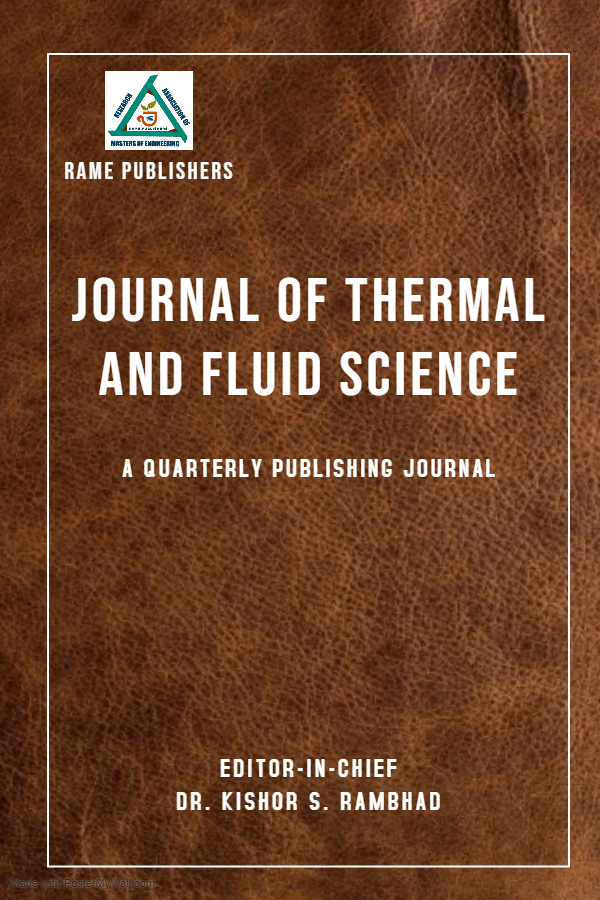Simulation of Micro-Chip Heat Sink to Investigate the Thermo-Fluid Behaviour and Temperature Distribution
Debasish Biswas, Krishna Ladha, Aditya Deb
Journal of Thermal and Fluid Science
Volume 3: Issue 1, June 2022, pp 32-37
Author's Information
Debasish Biswas1
Corresponding Author
1Assistant Professor, Department of Mechanical Engineering, Kalyani Government Engineering College, Kalyani-741235, India, India
debasishmechanical@yahoo.co.in
Krishna Ladha2, Aditya Deb3
2,3Student, Department of Mechanical Engineering, Kalyani Government Engineering College, Kalyani-741235, India
Abstract:-
The efficient cooling from heat sinks is important for the proper functioning and longevity of a central processing unit (CPU). In this Project, ANSYS simulation of a modified micro-fin heat sink was done and the results were analyzed to get an idea of the approximate rate of Heat transfer, Temperature distribution and Thermo fluid behavior of the heat sink mounted on the central processing unit. Air cooling methods by free convection and conduction are used for heat extraction. The simulation was based on the effects on inlet fluid velocity, design of fins and location of source on the performance of the Heat Sink. The Turbulent SST model is used. The Heat transfer rate, temperature and pressure distribution were obtained for different designs of fin. After complete analysis, an increased air flow velocity at inlet and thin sheet fins with source at the bottom of heat sink provides the most effective heat transfer rate.Index Terms:-
Micro-Chip Heat Sink, Heat Transfer, Temperature Distribution, Ansys, Turbulent SST Model .REFERENCES
- Rath, B.K. , Mahapatro, P.K. and Dash, D.K.(2017) Effect of Volume Fraction along with concentration parameter in the dusty incompressible flulid published in Adv. Appl. Fluid. Mech. 20, No: 1, pp 117-125
- Rath, B.K., Behera, G.K., and Dash, D.K. (2015). Solution of Longitudinal velocity of the fluid and the particle of he dustu fluid with the effect of volume fraction in the incompressible fluid of SPM. Adv. Appl. Fluid. Mech. 18, 155-162
- Panda, T.C., Mishra, S.K., and Panda, K.C. (2001) Volume fraction and diffusion analysis in SPM modeling in an inertial frame of reference, Acta Ciencia Indica, XXVIIM, No. 4, 515.
- Panda, T.C., Mishra, S.K., and Panda, K.C.(2001b) Induced flow of suspended particulate matter (SPM) due to time dependent horizontally oscillating plate, Acta Ciencia Indica, Vol. 27M, (2), 233-239.
- Panda, T.C., Mishra, S.K., and Panda, K.C.(2002) Diffusion of suspended particulate matter using two-phase flow model to be published in Int. J. for Numerical Methods in Fluids, New York.
- Purcell, E.M. (1978) The effect of fluid motions on the absorption of molecules by suspended particles, J. Fluid Mech. 84, 551-559.
- Panda, T.C., Mishra, S.K., and Dash D.K. (2006) Modelling Dispersion of SPM in free convection flows in the vicinity of heated horizontal flat plate in Impact J. Sci. Tech. 1, 37-60.
- Rath, B.K. and Ganesh, V. (2014) The longitudinal pretreated fluid velocity of the dusty fluid in the incompressible flow in cylindrical polar coordinates in Int. J. Res. Engg. Tech. 03, 769-772.
- Dash,D.K ; Rath,B.K., published a paper entitled”Effect of volume fraction on temperature in axi symmetric jet mixing of incompressible flow in cylindrical polar coordinates “ in Applied Science Periodical in volume xiii, No -1 , February 2011.
- Dash,D.K and Rath,B.K., published in IJERIA entitled “Modelling of boundary layer equation in axi symmetric jet mixing of incompressible flow in cylindrical polar coordinates along with volume fraction effect, Vol-2, No.11, 2009, pp 259 – 268”
- Dash,D.K ; Rath,B.K., Impact J.Sci.Tech entitled “Modelling of boundary layer equation in axi-symmetric, incompressible flow in cylindrical polar coordinates and its simplification , Vol 2(1) , 1-8, 2008,FIJI ISLANDS.”
- Dash,D.K and Rath,B.K., published in Far East J.Appl. Math, entitled “ Effect of volume fraction in axi symmetric jet mixing of incompressible flow in cylindrical polar coordinates, 34(1),2009,83-94.”
To view full paper, Download here
To View Full Paper
For authors
Author's guidelines Publication Ethics Publication Policies Artical Processing Charges Call for paper Frequently Asked Questions(FAQS) View All Volumes and IssuesPublishing with




